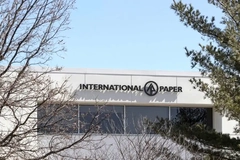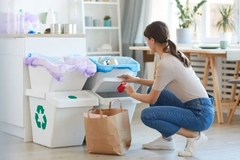Wood and aluminum outpace plastic and glass packaging, report finds

12 Aug 2024 --- Wood and aluminum packaging product sales have increased compared to plastic and glass, finds a new report by Valpak and the Waste & Resources Action Programme (WRAP).
The PlasticFlow report recommends that more research be carried out to quantify the recyclability of plastic packaging. It adds that further work on the definition of agricultural films — such as what is classified as a packaging application — should be carried out.
The report also found that it is difficult to accurately calculate the amount of stretch wrap used in transit packaging, recommending further work be done to quantify films used for delivery packaging.
Griff Palmer, economist at WRAP, tells Packaging Insights that the PlasticFlow report highlights the need for improved data accuracy for commercial and industrial plastic packaging films.
“[The report] also identifies that the incorrect allocation of packaging recovery note (PRN)/packaging waste export recycling note (PERN) to non-packaging films or non-UK packaging film may cause estimates for non-consumer film recycling rates to be too high.”
Increased plastic packaging sales have likely been offset by light-weighting activity, WRAP identifies. The organization concludes that its findings support a longstanding belief in the plastics packaging industry that lightweighting efforts effectively counterbalanced any potential increases in consumption.
The sentiment on lightweighting had previously been contested by A Plastic Foundation, which stresses: “A reduction in the weight of plastic packaging does not influence the likelihood that it will end up in the ocean. If the lighter packaging enters the environment after usage, it will, in fact, break down into smaller pieces more quickly than packaging that is thicker and stronger.”
However, WRAP claims that Industry members have provided evidence to justify lightweighting to the project team. But the report authors say the information is considered to be “commercially sensitive” and therefore cannot be provided in this report.
 The probabilities of meeting UK plastic recycling targets are “high,” shows the report.The report’s central findings
The probabilities of meeting UK plastic recycling targets are “high,” shows the report.The report’s central findings
PlasticFlow 2025 was published to support the UK Department for Environment, Food & Rural Affairs (Defra) in its understanding of current levels of UK plastic packaging placed on the market (POM) and recycled, and forecast potential future levels up to 2025.
PlasticFlow also outlines the potential UK and European compliance challenges related to projected plastic packaging POM and recycling.
The PlasticFlow report provides updated estimates for plastic packaging POM and recycling rates in the UK for 2022, and projects plastic packaging POM through 2028. Plastic packaging POM is estimated to be 2,082,000 metric tons (+/- 6%) in 2022.
Two scenarios were run projecting plastic packaging POM in 2028. In Scenario 1, all packaging materials are subject to recycling obligations under 2007 Regulations for 2024 and under new EPR regulations from 2025 onward. In this scenario the projected plastic packaging POM for 2028 is 2,166,000 metric tons.
In Scenario 2, in-scope DRS drinks containers, excluding glass drinks containers, are removed from EPR POM quantities from 2027 onward. In this scenario, the projected plastic packaging POM for 2028 is 1,759,000 metric tons.
Furthermore, the domestic plastic packaging recycling rate in the UK in 2022 is estimated to be between 44% and 62%. The difference in estimated recycling rate is accounted for by the point of measurement.
If measuring recycling (by weight) on entry to a reprocessor, the UK’s domestic plastic packaging recycling rate is estimated at 62% (1,285,000 metric tons recycled). If measured after conversion on exit from reprocessing, the rate is 44% (925,000 metric tons recycled).
Cross material sales
For most materials, the amount of packaging POM has decreased compared to 2019.
Between 2019 and 2022, the estimated amount of plastic packaging POM in the UK decreased from 2,290,000 metric tons to 2,082,000 metric tons.  For most materials, the amount of packaging POM has decreased compared to 2019.
For most materials, the amount of packaging POM has decreased compared to 2019.
Palmer says that during the same time period, decreases were also seen for glass packaging, which fell from an estimated 2,574,000 metric tons to 2,562,000 metric tons. Paper and card packaging fell from 4,990,000 metric tons to 4,843,000 metric tons and steel packaging fell from 517,000 metric tons to 474,000 metric tons.
“Over the same 2019 to 2022 time period other packaging materials saw increases in the estimated amount of packaging POM. Wood packaging increased from 1,358,000 metric tons to 1,385,000 metric tons, and aluminum packaging increased from 222,000 metric tons to 257,000 metric tons.”
Plastic packaging compliance
The UK is likely to meet packaging recycling targets in 2018, 2019 and 2020, finds the report. Assuming that the 2018 POM figure of 2,361,000 metric tons applies, based on this report’s projections of plastic packing POM and plastic packaging recycling, the UK is likely to meet packaging recycling targets in 2018, 2019, 2020 and the CEP target in 2025.
The probabilities of meeting UK recycling targets in 2018, 2019 and 2020 are “high,” as is the probability of achieving the 2025 CEP target, shows the report. Meanwhile, the probabilities of meeting the national equivalents of the business targets in 2018, 2019 and 2020 are 84%, 87% and 90% respectively and 100% for the CEP target in 2025.
“However, without further action, The UK Plastics Pact target of 70% of plastic packaging effectively recycled or composted by 2025, would be missed,” warn Valpak and WRAP.
WRAP is working with The UK Plastics Pact members and supporters to develop and implement the required actions.
By Natalie Schwertheim











